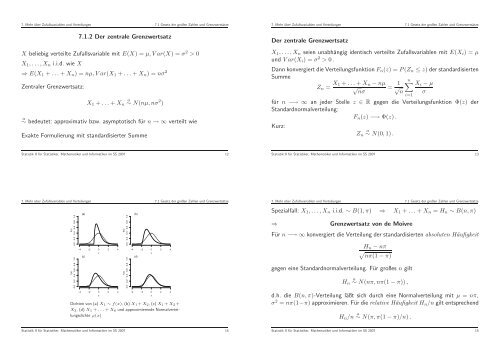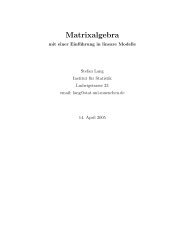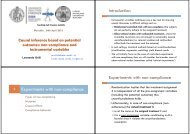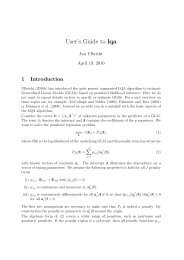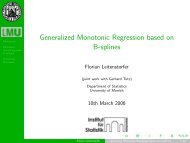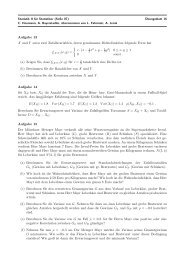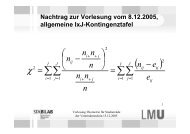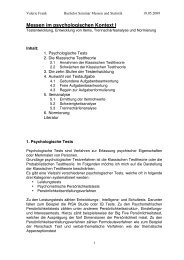Statistik II für Statistiker, Mathematiker und Informatiker (SS ... - LMU
Statistik II für Statistiker, Mathematiker und Informatiker (SS ... - LMU
Statistik II für Statistiker, Mathematiker und Informatiker (SS ... - LMU
Sie wollen auch ein ePaper? Erhöhen Sie die Reichweite Ihrer Titel.
YUMPU macht aus Druck-PDFs automatisch weboptimierte ePaper, die Google liebt.
7. Mehr über Zufallsvariablen <strong>und</strong> Verteilungen 7.1 Gesetz der großen Zahlen <strong>und</strong> Grenzwertsätze<br />
7.1.2 Der zentrale Grenzwertsatz<br />
X beliebig verteilte Zufallsvariable mit E(X) = µ,V ar(X) = σ 2 > 0<br />
X 1 , ...,X n i.i.d. wie X<br />
⇒ E(X 1 + ... + X n ) = nµ,V ar(X 1 + . .. + X n ) = nσ 2<br />
Zentraler Grenzwertsatz:<br />
X 1 + ... + X n<br />
a<br />
∼ N(nµ, nσ 2 )<br />
a<br />
∼ bedeutet: approximativ bzw. asymptotisch <strong>für</strong> n → ∞ verteilt wie<br />
Exakte Formulierung mit standardisierter Summe<br />
7. Mehr über Zufallsvariablen <strong>und</strong> Verteilungen 7.1 Gesetz der großen Zahlen <strong>und</strong> Grenzwertsätze<br />
Der zentrale Grenzwertsatz<br />
X 1 , ...,X n seien unabhängig identisch verteilte Zufallsvariablen mit E(X i ) = µ<br />
<strong>und</strong> V ar(X i ) = σ 2 > 0 .<br />
Dann konvergiert die Verteilungsfunktion F n (z) = P(Z n ≤ z) der standardisierten<br />
Summe<br />
Z n = X 1 + ... + X n − nµ<br />
√ = 1 ∑ n<br />
X<br />
√ i − µ<br />
nσ n σ<br />
<strong>für</strong> n −→ ∞ an jeder Stelle z ∈ R gegen die Verteilungsfunktion Φ(z) der<br />
Standardnormalverteilung:<br />
F n (z) −→ Φ(z) .<br />
Kurz:<br />
Z n<br />
a<br />
∼ N(0, 1).<br />
i=1<br />
<strong>Statistik</strong> <strong>II</strong> <strong>für</strong> <strong>Statistik</strong>er, <strong>Mathematiker</strong> <strong>und</strong> <strong>Informatiker</strong> im <strong>SS</strong> 2007 12<br />
<strong>Statistik</strong> <strong>II</strong> <strong>für</strong> <strong>Statistik</strong>er, <strong>Mathematiker</strong> <strong>und</strong> <strong>Informatiker</strong> im <strong>SS</strong> 2007 13<br />
7. Mehr über Zufallsvariablen <strong>und</strong> Verteilungen 7.1 Gesetz der großen Zahlen <strong>und</strong> Grenzwertsätze<br />
f(x)<br />
f(x)<br />
0.0 0.2 0.4 0.6 0.8 1.0<br />
0.0 0.2 0.4 0.6 0.8 1.0<br />
(a)<br />
−4 −2 0 2 4<br />
(c)<br />
x<br />
−4 −2 0 2 4<br />
x<br />
f(x)<br />
f(x)<br />
0.0 0.2 0.4 0.6 0.8 1.0<br />
(b)<br />
−4 −2 0 2 4<br />
x<br />
−4 −2 0 2 4<br />
Dichten von (a) X 1 ∼ f(x), (b) X 1 + X 2 , (c) X 1 + X 2 +<br />
X 3 , (d) X 1 + . . . + X 6 <strong>und</strong> approximierende Normalverteilungsdichte<br />
ϕ(x)<br />
0.0 0.2 0.4 0.6 0.8 1.0<br />
(d)<br />
x<br />
7. Mehr über Zufallsvariablen <strong>und</strong> Verteilungen 7.1 Gesetz der großen Zahlen <strong>und</strong> Grenzwertsätze<br />
Spezialfall: X 1 , ...,X n i.i.d. ∼ B(1,π) ⇒ X 1 + ... + X n = H n ∼ B(n,π)<br />
⇒<br />
Grenzwertsatz von de Moivre<br />
Für n −→ ∞ konvergiert die Verteilung der standardisierten absoluten Häufigkeit<br />
H n − nπ<br />
√<br />
nπ(1 − π)<br />
gegen eine Standardnormalverteilung. Für großes n gilt<br />
H n<br />
a<br />
∼ N(nπ, nπ(1 − π)) ,<br />
d.h. die B(n,π)-Verteilung läßt sich durch eine Normalverteilung mit µ = nπ,<br />
σ 2 = nπ(1−π) approximieren. Für die relative Häufigkeit H n /n gilt entsprechend<br />
H n /n a ∼ N(π, π(1 − π)/n) .<br />
<strong>Statistik</strong> <strong>II</strong> <strong>für</strong> <strong>Statistik</strong>er, <strong>Mathematiker</strong> <strong>und</strong> <strong>Informatiker</strong> im <strong>SS</strong> 2007 14<br />
<strong>Statistik</strong> <strong>II</strong> <strong>für</strong> <strong>Statistik</strong>er, <strong>Mathematiker</strong> <strong>und</strong> <strong>Informatiker</strong> im <strong>SS</strong> 2007 15


